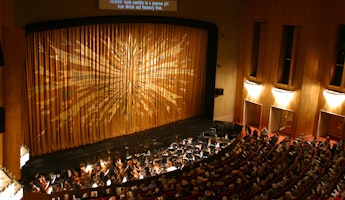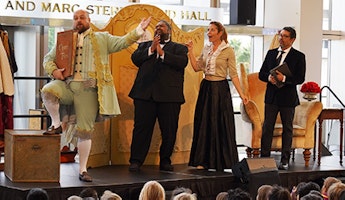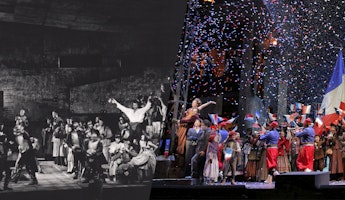Blog
December 8, 2022
"Tosca": James Conlon's Note
Tosca: A Personal History
I usually also write an article with some reflections which complement those talks, be they live or, since the Covid pandemic, prerecorded.
I went back into my file of the many articles that I have written over the years for various occasions and discovered that, for a reason I no longer remember, I had never written one about Tosca. I determined to write one this season, but partially due to a heavy rehearsal and performance schedule over the last two months, I had trouble getting started. Eventually I concluded that Tosca had inspired a type of writer's block. I am not sure why.
To break that block, I started musing on my personal history and experience of this opera. It led me down a path of reminiscences that invaded my being and did not leave the requisite space for an article dealing in abstracts, critical commentary, analyses of contemporary relevance (or irrelevance). In short, all the stuff of writing about opera.
And then, for a very short break from work, the first in several months, I found myself in the best place to think and write about my feelings about Tosca: Rome. I was staying with friends who had invited a group of architects and architectural critics to dinner on the night I arrived. They essentially talked shop all evening, and I, having nothing to contribute, listened. They spoke about Rome and its unique architectural grandeur spanning several millennia.A thought popped into my head: the architecture of Tosca is, literally, that of Rome.
I could think of no other opera as rooted in the substance, specificity and detail of the city in which its drama plays out. In the original 1887 play that Puccini used as his source material, French playwright Victorien Sardou had chosen a specific date—June 14, 1800—as well as very specific locations: a church, St. Andrea del Quirinale (which Puccini changed to the much larger St. Andrea della Valle), the Palazzo Farnese and the Castel Sant'Angelo. All the action in both the drama and the opera (for which Puccini excised all subplots and Sardou's plethora of historical details) takes place within 24 hours. Puccini's Tosca premiered at the Rome Opera, appropriately, on January 14, 1900, exactly five months short of the centenary of events depicted in the opera surrounding the victory of Napoleon's troops at the Battle of Marengo.
It is therefore, in many senses, a Roman opera. We are all familiar with updating opera productions, as well as changing the locales of the action. It is commonplace in today's opera world. Without going into the merits and demerits of doing so, I think that, of course, one can change the time and place of an opera, but one need not do so to make it compelling in today's world. Various operas benefit from it, others are indifferent to it, and some set the bar very high for a theatrical improvement on the original. I would put Tosca in a very select class of operas that is theatrically and dramatically so compelling as conceived by Puccini and his collaborators, that it is very hard to surpass the original.
This is not an accident. As a point of comparison: in the course of almost 30 years of composing operas, Gaetano Donizetti wrote some 70 operas. Puccini, over 40 years, wrote only 12, ten if you consider Il Trittico as one. Perhaps no other composer expended the time and effort, to construct the dramatic details and marry them to his music as did Puccini. In the context of his times, Giuseppe Verdi revolutionized Italian opera as drama. Puccini went further. He researched the subject, times, geographical and culture detail to an unprecedented degree (and then described them in the score!!!). The dramatic instructions and details of the decor and actions lining his musical scores (known as didascalia) knows almost no contemporary equivalent.
Like Verdi, Puccini was always fascinated with the wider world, composing only two operas on Italian subjects, preferring stories set in the Black Forest, Flanders, Paris, Japan, the American West and ancient China. It should be born in mind that although from the outside, many view Italy as a unity, it was anything but that over the course of its long history. Puccini was quintessentially Tuscan, and Tuscany and Rome were two separate cultures, even two separate countries, at the time of the composer's birth. For Tosca, Puccini studied Rome not as a native, but as he had previously studied Paris, exploring its character and its culture, down to the authenticity and notation of the pre-dawn bells heard at the beginning of Act Three.
My memories went back to my twentieth year. Rome was the first great European city I visited, and for years to come, it was my first stop for every summer vacation. Those memories from half a century ago still remain with me. But what leads me back to Tosca is the unique recollection that when I first arrived in Rome, I felt as if it were familiar and I already "knew" it. There were two reasons.
The first was that, having been raised as a Roman Catholic, the images of St. Peter's, the Vatican and the papacy were already vivid. But the second reason was, having first seen Tosca at the age of 13, then singing in the children's chorus at 14 (with a falsetto, to hide the fact that my voice had long since changed), and having collected several recordings, every one of them with a picture of the diva—Leontyne Price, Renata Tebaldi or Maria Callas—shown in front of the Castel Sant'Angelo, the images of Rome were already familiar to me at a young age.
Within the first 24 hours of my very first visit to Rome, I had seen the interior of the Church of St. Andrea della Valle. I evoked an ecclesiastical procession for the Te Deum and wondered where Mario might have been painting his Maddalena or where the Attavanti chapel might have been. I walked past and stared at the exterior of the Palazzo Farnese (it was impossible to go inside) and climbed to the top of Castel Sant'Angelo, imagining Mario and Tosca, the firing squad and what it would be like to look down from the parapet and then jump. The whole final act played out in my mind.
Of course, I understand that the protagonists, personal dramas and interactions were entirely created by Sardou, but he chose the locations of each act with an eye towards Aristotle's unities of time, place and action, placing his drama into a deeply researched period of Roman history.
Passion, Religion and Politics—An Unholy Trinity—and the Pursuit of Happiness
Rome in 1800, heated in the cauldron of post-revolutionary ferment, was captured by Sardou nearly a century later in a play, which Puccini recast as an opera in 1900, a similar time of societal turmoil. Both turns of the century were also periods of intense anticlericalism in Italy. The political conflict between the Vatican as a temporal power and the newly emerging Italian nation wouldn’t officially end until the 1929 Lateran Treaty. This agreement was made in the name of Pope Pius XI and King Vittorio Emanuele III, and it was signed by Benito Mussolini, representing the Italian nation.
As popular as it is, not everyone loves and admires Tosca. It has inspired revulsion by some musicologists and musicians. Dimitri Shostakovich is believed to have said that it was "a great opera, but terrible music." As an ardent lover of Shostakovich's music, I am fascinated by that remark. I understand his not liking the music, for their aesthetic milieus are worlds apart, but his apparent admiration for the opera’s construction of Tosca is intriguing.
Joseph Kerman, an influential musicologist and critic, launched a full attack on Tosca in his seminal 1956 book Opera as Drama. When he revised his book 30 years later, he seemed to express some regrets...but not really. Even as a 14-year-old, when I first read this, I was enraged and indignant at his dismissive attitude. I no longer expend my energy on those negative reactions; I can only say that, if Tosca is as bad as he thought, it would not have stood the test of time and continue to keep its place in the operatic world.
I would love to entertain those arguments, pro and con....some another time.
Building on Verdi’s legacy, Tosca continued onward toward modernity. Nineteenth-century operas, like those of Verdi, were organized as a series of scenes. Each scena was basically a five-part closed form, with a beginning, a middle and an end. These were strung together to build acts and to provide opportunities for the public to applaud the artists. The scena was opera's basic unit of the currency—the dollar if you will. But by the last two decades of the 19th century, that form had run its course. It was expanded and replaced by an uninterrupted dramatic and musical flow, making the much longer act the essential unit.
Puccini's operas are a long way from the bel canto operas of Rossini, Donizetti and Bellini. There is even a considerable difference from those of Verdi, even though Puccini had written five operas before the death of his illustrious predecessor.
Richard Wagner's influence on Puccini cannot be overstated. The Wagnerian principles of continuous uninterrupted acts, the clarity of text, the avoidance of ensembles and chorus that would blur that text were not lost on him. He drew inspiration from the dominant and dominating role of the orchestra in Wagner. But Puccini's music has its own voice. For his texts, he abandoned two centuries of tradition (in both Italian opera and in Wagner) by turning away from poetry; the libretto is now pure prose. He was a sponge, soaking up all of the newest trends from the rest of Europe, from France, Germany and Austria, as well as his native Italy.
As a young man, he went to Bayreuth, and he had access to all of Wagner's scores. From them, he learned Wagner's Leitmotif system. These musical motives can be associated with persons, events, objects or emotions. They can interact with one another. They are always enunciated by the orchestra, which seems to know things the characters do not. They can recount, make associations and reveal unconscious feelings to the listener. In Wagner's hands, the orchestra became a type of musical/dramatic universe, seemingly omniscient, which the characters of the drama navigate. Puccini follows in his footsteps. Although Puccini used this system differently, no other Italian composer of his period so effectively absorbed it.
After Verdi's monumental success of characterizing Iago in Otello, it is not surprising that Puccini was inspired to portray Scarpia’s wickedness in a similarly complex way. Tosca follows Verdi’s masterpiece by only 13 years. With Iago (whom Scarpia mentions in Act One), the blueprint for Scarpia was already there for Puccini to follow. Scarpia has another more immediate example of attempted sexual violence in Umberto Giordano's Andrea Chenier (1896), which premiered right at the time that Puccini was in the first planning stages of Tosca.
The opera, impressively concise, respects Aristotle's unities of time, place and action. Everything takes place within 16 hours, in three locations within walking distance of each other. The entire narrative is densely concentrated. It has no superfluous distractions nor concessions to musical, or non-dramatic distractions, with the exception of a poetic portrait of early morning in Rome with its symphony of church bells.
Puccini's opera was premiered, appropriately, in Rome, 100 years after the events depicted on the stage. It points forward to many important developments of 20th-century opera in terms of realism, gritty personal passions, use of political/religious conflicts, violence and murder. It is rarely given its due as a visionary work. The century was newborn on the date of its premiere: January 14, 1900. In more ways than one, it can claim to be the first great opera of the 20th century.
@ James Conlon, Rome, 2022








/03-cosi/_dsc0996_pr.jpg?format=auto&fit=crop&w=345&h=200&auto=format)















